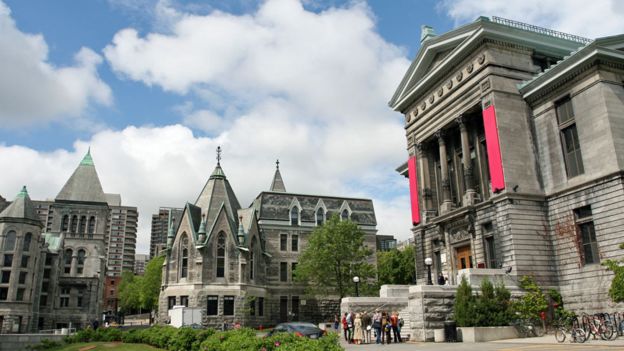Do international students get what they pay for?
-
20 May 2019
 Image copyrightUOT
Image copyrightUOTCanada is competing against countries like the UK and US for the minds – and wallets – of international students. But what happens once they get there?
Jobandeep Sandhu is a hard worker.
The 22-year-old worked pretty much full time as a truck driver while studying to be a technical engineer, so he could help put himself and his brother through college in Ontario.
“My thinking was that working isn’t a crime,” he said.
But now the Indian citizen is facing deportation after he was arrested for working too many hours as an international student.
Sandhu’s student visa stipulated that he can only work off-campus up to 20 hours a week during the school year. Yet some weeks he was working as much as 40.
Sandhu said he did this because his parents could not afford the high cost of international tuition for both himself and his brother, plus the living expenses. When an officer pulled him over during a routine traffic stop and asked to see his trucking log books, Sandhu readily turned them over.
“I was working legally, I was paying taxes,” he said.
“I thought that I don’t need to lie.”
Since then, he has had to hire a lawyer to fight his deportation, which is scheduled for 21 May.
 Image copyrightSUBMITTED PHOTO
Image copyrightSUBMITTED PHOTOSandhu is not alone in struggling to pay the bills.
There are currently more than 500,000 international students in Canada, and international tuition rates have risen 32% across the country, compared to 14% for domestic students.
Since his arrest, several advocates have spoken about the need to be more accommodating of international students who need to work.
“They absolutely need to be able to seek employment,” says Adam Brown, chair of the Canadian Alliance of Student Associations and a student at the University of Alberta.
The calls for change come at a time when Canada is trying to aggressively compete with other countries around the world to attract international students.
For years local and federal governments have been pulling out all the stops to draw in students from around the world.
Canada has relaxed rules around off-campus work and made it easier for international students to get a work visa after graduation or apply for permanent residency. The latest federal budget has earmarked $148m (£86m) over the next five years, in part “to promote Canadian education institutions as high-calibre places to study”.
Economics 101
It is all about the bottom line, according to Dani Zaretsky, an international student recruiter.
“Globally – it’s not just Canada – there’s no mistaking it’s all about money,” says Zaretsky, who co-founded recruitment company Higher Edge and has worked with several Canadian universities and colleges to help boost international student enrolment.
“If there are other benefits [like diversity], they’re welcome, but it’s not the point.”
On average, international students in Canada can expect to pay four times more tuition than domestic students.
Similar formulas apply in other countries. At the University of California in San Diego, where about 20% of students come from outside the US and pay $40,327 a year in tuition, which is about three times the American rate.
A similar number of students at the UK’s University of Manchester also come from abroad, and pay £18,500 a year in tuition, twice the rate of domestic students.
 Image copyrightGETTY IMAGES
Image copyrightGETTY IMAGESAt a time when many governments are cutting back on their education spending, international students are a crucial form of revenue for many institutions.
Canada is ranked sixth in the world as a destination for international students, according to research conducted by research group Project Atlas. That puts it behind the US, UK, China, Australia and France – and down two spots from the year before.
Why Canada?
So what makes an international student willing to shell out so much cash?
For Bangladeshi student Kazi Mridul, it was the promise of a high-quality technical education, coupled with Canada’s reputation as a welcoming, multicultural country.
“There’s more funding for research, especially in the STEM field [science, technology, engineering and maths],” said Mridul, who is studying engineering at Toronto’s York University.
Canada also makes it easy for international students to apply for a post-graduate work permit, a policy the UK has discussed adopting, to increase its appeal abroad.
But Mridul says the visa process could still be easier.
“School accepted me in March, but until August I didn’t know if I was coming or not,” he says.
Do students get what they pay for?
The Ministry of Global Affairs estimated that in 2014 alone, international students spent $11.4 billion in the Canadian economy. Since then, the number of international students has grown from 330,170 to 572,415 – an almost 75% increase.
Meanwhile, average international tuition fees have been raised from $20,593 to $27,159, or by about 32%.
Yet it is not clear that international students are getting any more for their dollar than they were before.
Zaretsky says services have not kept up.
If Canada is really committed to attracting more international students, it should be clear about what it’s offering them, he says, and that includes an opportunity to work once they arrive.
 Image copyrightGETTY IMAGES
Image copyrightGETTY IMAGESHe also thinks schools need to be careful about how much they raise tuition, year-to-year.
“Sometimes they’ll raise it 10-12% in a fell swoop, and for families that have budgeted carefully that’s a rude shock,” he says.
Ultimately, Mridul does think his Canadian education was worth it.
“It’s not just the education, it’s the whole experience,” he says.
“It’s all the other people that are here. In Bangladesh we have a very homogenous society… here it’s the exposure to everything.”
Source:BBC News
